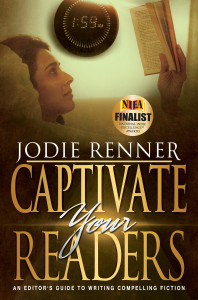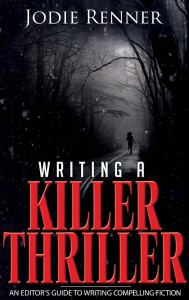 by Jodie Renner, editor & author
by Jodie Renner, editor & author
[By the way, check out our growing list of resources in the TKZ Library.]
Congratulations! You’ve gotten a first draft of your story down, perhaps after writing madly for NaNoWriMo. Now it’s time to go back and reassess each scene to see if it’s pulling its weight.
Besides advancing the storyline, scenes should: reveal and deepen characters and their relationships; show setting details; provide any necessary background info (in a natural way, organic to the story); add tension and conflict; hint at dangers and intrigue to come; and generally enhance the overall tone and mood of your story.
To bring your characters and story to life, heighten reader engagement, and pick up the pace, try to make your scenes do double or even triple duty – but subtly is almost always best.
For example, a scene with dialogue should have several layers: the words being spoken; the viewpoint character’s real thoughts, opinions, emotions, and intentions; the other speaker’s tone, word choice, attitude, body language, and facial expressions; and the outward reactions, attitudes, and actions of both.
Ten key ways you can intensify your writing and enhance the experience for readers:
1. When introducing new characters, remember to show, rather than tell. Reveal their personality, motives, goals, fears, and modus operandi not by telling the readers about them or their background, but by their actions, words, body language, facial expressions, tone, and attitude. If it’s a viewpoint character, show their thoughts, emotions, and physical sensations. Also, show characters’ reactions to each other. Then let the readers draw their own conclusions about the characters and their true intentions.
2. Enhance your descriptions of the setting and other characters by filtering them through the mood, attitude, and reactions of the POV character for the scene. This not only gives the readers a visual image of whatever the character is looking at, but helps with character development. We learn more about the character’s personality and what is driving / motivating him by his observations of his surroundings and others around him. And add in other sensory reactions – sounds, smells, even tastes and tactile sensations.
3. Use close point of view to deepen characterization of the protagonist and other POV characters by showing inner conflict, doubt, or indecision, or by contrasting their words and outward reactions with their true inner feelings.
4. Make dialogue do double-duty. Dialogue should not only convey information, but also reveal character & personality and advance the storyline. Dialogue action tags, which can replace “he said” and “she said,” tell us both who’s speaking and what they’re doing, as well as often providing info on how they’re feeling and reacting. For example:
Chris stood up and ran his hand through his hair. “What the hell are you talking about?”
Jesse set his coffee down, determined to stay calm. “Hey, man, relax. I told you about it last week. Don’t you remember?”
5. Show subtext during dialogue. A couple might be arguing heatedly about something fairly trivial, when inside one or both are really angry or resentful about deeper problems, which you can hint at by inner reactions, or which can come out at the end of the scene or later.
6. Introduce suspense or heighten anticipation through the use of hints and innuendos, or snippets/fragments of critical information.
7. Show sexual tension between love interests by revealing heightened sensory perceptions and physical reactions. Be sure to show the inner reactions and often-conflicted feelings of your POV character.
8. Show brief flashbacks to reveal character secrets and fears, little by little.
9. Deepen connections between characters by having them discover similar values and goals, and showing these through dialogue, tone, body language, actions, etc.
10. Increase the conflict between characters by showing opposing goals and values, through dialogue, body language, tone of voice, facial expressions, etc.
How the experts do it. Here’s an example of a brief scene with lots of intriguing info subtly embedded in it, presented in a natural, casual way, organic to the character and the situation:
This is how James Lee Burke introduces his main character, Dave Robicheaux, as well as the local executioner, Val Carmouche, on page 2 of Purple Cane Road (Robicheaux is narrating, in first person.):
That was when I was in uniform at NOPD and was still enamored with Jim Beam straight up and a long-neck Jax on the side.
One night he found me at a table by myself at Provost’s and sat down without being asked.
[…]
“Being a cop is a trade-off, isn’t it?” Vachel said. […] “You spend a lot of time alone?”
“Not so much.”
“I think it goes with the job. I was a state trooper once.” His eyes, which were as gray as his starched shirt, drifted to the shot glass in front of me and the rings my beer mug had left on the tabletop. “A drinking man goes home to a lot of echoes. The way a stone sounds in a dry well. No offense meant, Mr. Robicheaux. Can I buy you a round?”
As a first-time reader of Burke, I found out quite a bit about his main character through this very brief scene on page 2, including that Dave was in the NOPD, had at least somewhat of a drinking problem, and was probably lonely. I’m definitely intrigued and want to read more.
Writers – Do you have any points/techniques to add? Would you like to share a paragraph or two in your writing where you do double (or triple) duty to enhance a scene?
 Readers – Can you give us a powerful paragraph or two from a book you’ve enjoyed, where the author has effectively accomplished several things at once?
Readers – Can you give us a powerful paragraph or two from a book you’ve enjoyed, where the author has effectively accomplished several things at once?






